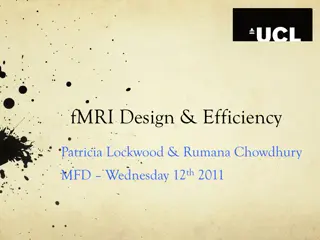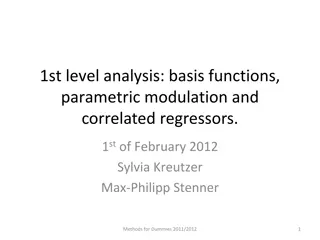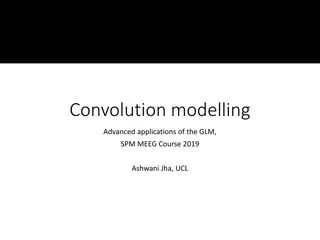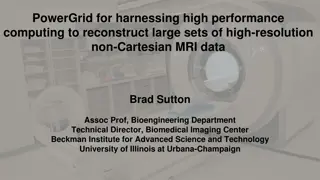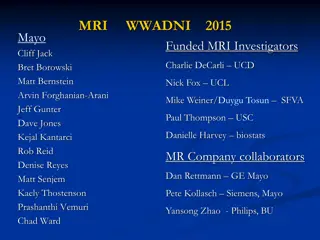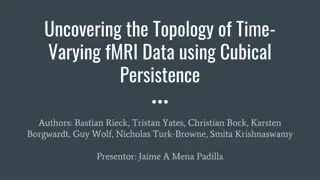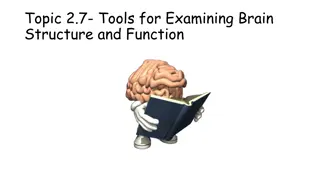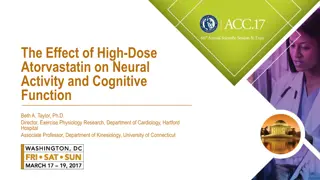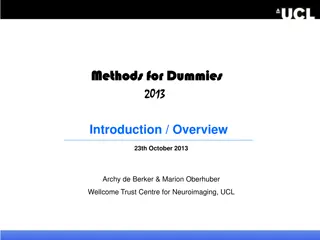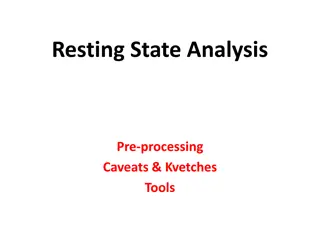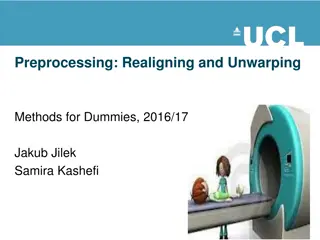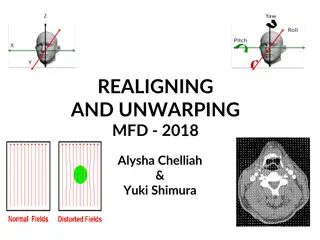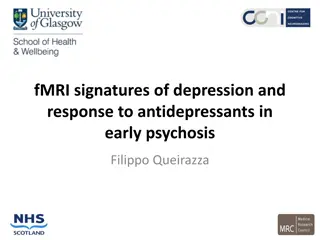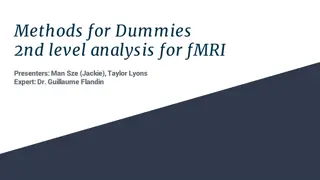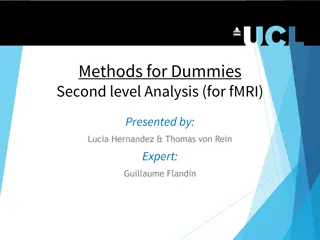fMRI Coregistration and Spatial Normalization Methods
fMRI data analysis involves coregistration and spatial normalization to align functional and structural images, reduce variability, and prepare data for statistical analysis. Coregistration aligns images from different modalities within subjects, while spatial normalization achieves precise anatomic
3 views • 35 slides
Coregistration and Spatial Normalization in fMRI Analysis
Coregistration and Spatial Normalization are essential steps in fMRI data preprocessing to ensure accurate alignment of functional and structural images for further analysis. Coregistration involves aligning images from different modalities within the same individual, while spatial normalization aim
6 views • 42 slides
Spatial Distortion Correction in EPI Sequences: Field Mapping Examples
Spatial distortion artifacts in EPI sequences (BOLD or DWI) due to slow sampling rates in the phase encoding direction can be corrected using B0/spatial field mapping techniques. This correction requires obtaining field maps under the same B0 shimming conditions and with identical FoV and adjustment
4 views • 4 slides
fMRI 1st Level Analysis: Basis Functions and GLM Assumptions
Explore the exciting world of fMRI 1st level analysis focusing on basis functions, parametric modulation, correlated regression, GLM assumptions, group analysis, and more. Dive into brain region differences in BOLD signals with various stimuli and learn about temporal basis functions in neuroimaging
1 views • 42 slides
Pioneering Innovation in Brain Imaging: The Center for Morphometric Analysis (CMA)
Dr. Verne Caviness, along with colleagues David Kennedy and Pauline Filipek, founded the Center for Morphometric Analysis (CMA) in 1988 at MGH, playing a significant role in the development of computer-assisted programs for precise volumetric imaging of the human brain using MRI. The CMA's early ach
2 views • 15 slides
Efficient fMRI Experimental Design: Maximizing Neurovascular Response
Understanding the importance of correctly designing fMRI experiments is crucial for testing specific hypotheses by manipulating stimulus types, timing, and participant instructions. Types of experimental designs include categorical, factorial, and parametric designs, each serving different purposes
0 views • 35 slides
Basis Functions and Hemodynamic Response Functions in fMRI Analysis
This content discusses the use of basis functions, parametric modulation, and correlated regressors in the first-level analysis of fMRI data processing. It delves into the concept of temporal basis functions for modeling complex functions of interest, such as the canonical hemodynamic response funct
1 views • 26 slides
Advanced Applications of Convolution Modelling in GLM and SPM MEEG Course 2019
Addressing difficulties in experimental design such as baseline correction, temporally overlapping neural responses, and systematic differences in response timings using a convolution GLM, similar to first-level fMRI analysis. The course focuses on the stop-signal task, EEG correlates of stopping a
1 views • 21 slides
PowerGrid: Reconstructing High-Resolution Non-Cartesian MRI Data for Bioengineering Research
PowerGrid is a cutting-edge system developed by Brad Sutton, Assoc. Prof. at the University of Illinois, for harnessing high-performance computing to reconstruct large sets of high-resolution non-Cartesian MRI data. This technology addresses the need for improved image reconstruction packages in MRI
0 views • 10 slides
Insights from "Thinking, Fast and Slow" and Neuroscience Advances
Explore the shift in understanding human rationality from the mid-20th century to the present through works like "Thinking, Fast and Slow" by Daniel Kahneman. Delve into the impact of strong emotions on decision-making, the role of unconscious thinking in decision processes as discussed in "Stranger
0 views • 63 slides
Advanced MRI Protocols for Neuroimaging Studies
Cutting-edge MRI protocols, ADNI 3, aim to enhance brain imaging techniques for clinical trials, focusing on precise measurements, disease detection, and potential treatment evaluation by leveraging advanced imaging methods like ASL, dMRI, and TF-fMRI.
0 views • 20 slides
Uncovering the Topology of Time-Varying fMRI Data using Cubical Persistence
Authors present a novel framework to transform time-varying fMRI data into topological representations, utilizing cubical persistence to analyze brain state trajectories and cluster participants based on topological features in blood flow in the brain, providing insights into cognitive processes. fM
0 views • 11 slides
Brain Structure and Function: Tools and Insights
Discover how scientists study the brain through accidents like Phineas Gage's, lesions, and advanced techniques like EEG, CAT, MRI, PET, and fMRI. Learn about the divided brain, split-brain patients, and the role of the corpus callosum in communication between brain hemispheres.
0 views • 8 slides
Preprocessing: Realigning and Unwarping
This material delves into the essential steps of preprocessing in fMRI analysis, focusing on realignment and unwarping techniques. The content covers the significance of preprocessing, stages in fMRI analysis, and the key assumptions underlying fMRI data processing. Violations of these assumptions a
0 views • 41 slides
Modeling BOLD Signal: Basis Functions & Regressors
Modeling the BOLD signal in fMRI involves understanding basis functions and correlated regressors. Basis functions capture the temporal dynamics of the BOLD response, which can vary between regions and subjects. Correlated regressors help account for this variability within the General Linear Model
0 views • 31 slides
Effect of High-Dose Atorvastatin on Cognitive Function
This study investigates the impact of high-dose atorvastatin on neural activity and cognitive function through a randomized clinical trial, utilizing neuropsychological assessments and fMRI tasks. Participants underwent cognitive testing after 6 months of treatment and again after a 2-month cessatio
0 views • 15 slides
Dynamic Causal Modelling
Peter Zeidman presents Dynamic Causal Modelling Advanced Topics at the Wellcome Trust Centre for Neuroimaging, University College London in October 2016. This course focuses on in-depth understanding and practical applications of dynamic causal modelling in functional magnetic resonance imaging (fMR
0 views • 34 slides
Human Brain Imaging Analysis Methods: A Comprehensive Overview
Explore the introductory insights into human brain imaging analysis methods, specifically focusing on fMRI and M/EEG. The program aims to cover basic statistics, fMRI (BOLD), EEG/MEG, connectivity, VBM, DTI, and more using SPM12. Join us for an in-depth exploration every Wednesday at FIL Seminar Roo
0 views • 76 slides
Introduction to Dynamic Causal Modelling in Neuroimaging
Explore the world of Dynamic Causal Modelling (DCM) in neuroimaging with Dr. Edda Bilek from Heidelberg University, Germany. Learn about modeling task-related fMRI data, estimating parameters, inferring model evidence, and specifying subject DCM in SPM. Understand structural, functional, and effecti
0 views • 25 slides
Unveiling Challenges and Solutions in Resting State Analysis Pre-processing
Explore the caveats, issues, and solutions in pre-processing resting state analysis data, highlighting artifacts, spikes, and global signal regression. Learn about tools and techniques to enhance data quality and interpret results effectively in RS-FMRI studies.
0 views • 9 slides
Understanding fMRI Preprocessing: Methods and Assumptions
Explore the essentials of fMRI preprocessing through realignment, unwarping, co-registration, and spatial normalization. Learn why preprocessing is crucial for analyzing fMRI data, the implications of violating key assumptions, and solutions to ensure data accuracy and reliability.
0 views • 41 slides
Understanding fMRI Preprocessing and Motion Correction in SPM
Dive into the world of fMRI analysis with a focus on preprocessing techniques, motion correction, and key assumptions to ensure accurate results. Discover why preprocessing is essential, how violation of assumptions can impact data quality, and solutions to overcome these challenges for reliable fMR
0 views • 29 slides
Understanding fMRI Signatures of Depression and Response to Antidepressants in Early Psychosis
Explore the intricate relationship between depressive and negative symptoms in early psychosis, utilizing fMRI to study response to antidepressants. Discover the overlapping symptom domains and implications for treatment efficacy, with a focus on identifying individual-level predictors and biomarker
0 views • 9 slides
Understanding 2nd Level fMRI Analysis: Fixed vs. Random Effects
Delve into the world of 2nd level fMRI analysis with a focus on Fixed and Random (Mixed) Effects models. Learn how to analyze group data to uncover significant effects not visible at the individual level. Explore the advantages and disadvantages of Fixed Effect Analysis versus Random Effects Analysi
1 views • 17 slides
Advanced fMRI Analysis Techniques: Second Level Insights
Explore second-level fMRI analysis techniques through an expert-led presentation covering fixed vs. random effects, statistical parametric maps, design matrices, contrast images, spatial preprocessing, and more. Enhance your understanding of group-level analysis and voxel activation differences acro
0 views • 31 slides
Functional MRI: Introduction, Concepts, Principles
Explore the world of functional MRI (fMRI) with this detailed guide covering introduction, key concepts, and guiding principles. Learn about AFNI, a powerful tool for fMRI data analysis, and delve into the essentials of fMRI technology. Discover how fMRI detects MRI-measurable signal increases in th
0 views • 20 slides
Understanding Functional MRI Principles and Concepts
Explore the principles and concepts of functional MRI (fMRI) through an in-depth look at AFNI software, its development, and the important principles guiding fMRI analysis. Discover the basics of fMRI, the significance of bug fixes, user support, and the tools available for pre-processing and analys
0 views • 20 slides
Insights into fMRI Applications in Humanistic Studies
Explore the diverse applications of functional magnetic resonance imaging (fMRI) in humanistic studies, including its role in diagnosing psychiatric disorders, identifying learning effects, and comparing psychological theories. Learn about the importance of collaboration, necessary tools for researc
0 views • 21 slides





